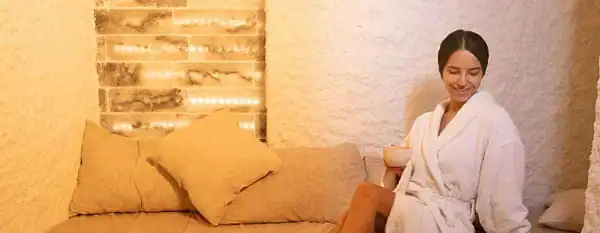Halotherapy, also known as dry salt therapy, is an alternative health treatment that has gained popularity in recent years for its potential benefits in alleviating respiratory and skin conditions. Originating in Eastern Europe, the practice involves spending time in a salt room or chamber, where salt particles are dispersed in the air for inhalation and absorption through the skin.
Advocates of halotherapy assert that the treatment can help with a variety of issues, such as asthma, sinus congestion, allergies, and eczema. They believe that the anti-inflammatory and antibacterial properties of salt can cleanse the respiratory system and improve skin health. However, it is important to note that scientific evidence supporting these claims remains limited, and further research is necessary to validate its efficacy and safety.
As an alternative therapy, halotherapy attracts individuals looking for complementary treatments alongside conventional medicine, as well as those who seek more natural and holistic approaches to maintaining their health. Before engaging in halotherapy, it is recommended that individuals consult with a healthcare professional to ensure the treatment is suitable for their specific needs and conditions.
History Of Halotherapy
Halotherapy has its roots in Eastern Europe, particularly in Poland. The practice dates back to the ancient times, when people who spent extended periods in salt caves and mines, observed improvements in their health and well-being.
In the 12th century, the Wieliczka Salt Mine in Poland became a significant center for halotherapy. The mine’s impressive health benefits gained recognition over time, and people suffering from respiratory illnesses sought time in its chambers. Miners working at Wieliczka reported having fewer respiratory issues and healthier skin compared to those working in other industries.
It was not until the 20th century that halotherapy gained scientific acknowledgement. In the 1840s, Polish physician Dr. Feliks Boczkowski, who treated patients at the Wieliczka Salt Mine, observed its positive impact on respiratory health. Later, in the 1980s, Russian scientists conducted research on salt therapy and developed the first halogenerator, a machine that simulates the microclimate of a salt cave by releasing dry salt particles into the air. Subsequent studies have supported the therapeutic effects of halotherapy for various respiratory and skin ailments.
Today, halotherapy is practiced worldwide and continues to gain popularity as a complementary therapy. Modern salt therapy centers and spas often utilize specially designed salt rooms, where clients can breathe in the salty air and experience the benefits similar to those found in natural salt caves.
Types Of Halotherapy
Halotherapy is implemented in a number of ways, primarily categorized into dry salt therapy and wet salt therapy. Furthermore, salt rooms may be either active or passive. Read on to learn more about each category.
Dry Salt Therapy
Dry salt therapy involves the use of a halogenerator, which disperses micronized salt particles into a salt room or salt cave. This method is inspired by the natural healing properties observed in salt miners and the concept of speleotherapy, where spending time in natural salt chambers has been believed to improve health. A salt room or cave is typically lined with Himalayan salt or other types of salt to create a controlled environment for optimal benefits.
In dry salt therapy, the halogenerator grinds the salt into very fine particles and it heats the salt to promote negative ion generation. The device also usually utilizes a fan to help circulate the air in the room and disperse the salt particles. it ensures that the concentration of salt particles in the air is maintained at a therapeutic level, allowing users to breathe in the salt and absorb it through their skin.
Regularly having salt therapy sessions may help manage symptoms of chronic conditions, such as asthma, COPD, cystic fibrosis, psoriasis, and eczema. Dry salt therapy may also be used seasonally as a preventative measure against allergies, common cold and other viruses. Dry salt therapy also promotes relaxatio, general wellness and may help with stress or jet lag.
While many of the pictures of Salt rooms make them look warm, Halotherapy is actually recommended at about 68 degrees Fahrenheit ( 20 degrees Celsius). Only the salt particles are heated in the process and it does not really heat up the room.
Wet Salt Therapy
Wet salt therapy includes various methods that utilize saline solutions or salt-enriched water for therapeutic purposes. Some of the common techniques in wet salt therapy are salt baths, saltwater inhalations, and flotation tanks. Salt baths involve soaking in water mixed with mineral salts to relieve muscle tension and promote relaxation. Saltwater inhalations involve inhaling saline mist, which helps to clear nasal passages and improve respiratory function. Flotation tanks, on the other hand, contain high concentrations of Epsom salt, which allows individuals to float effortlessly, promoting relaxation and mental well-being.
Active and Passive Salt Rooms
Active salt rooms are equipped with halogenerators that continuously disperse salt particles, ensuring a controlled environment for effective halotherapy. These rooms typically offer a more potent experience, as the concentration of salt particles is explicitly maintained for optimal benefits. Active salt rooms are more likely to yield a higher return on investment (ROI) for facility owners, as they can charge more for sessions.
Passive salt rooms, also known as “resting” salt rooms, do not utilize a halogenerator. Instead, the room is lined in or stacked with blocks of natural Himalayan salt, and users may benefit from the soothing environment and potential antimicrobial properties of the salt on the walls and floor. While passive salt rooms may not have the same controlled environment as active rooms, they can still offer a relaxing and therapeutic experience for users.

How Halotherapy Works
Halotherapy, also known as salt therapy, is a natural and holistic treatment that involves inhaling aerosolized particles of sodium chloride in a controlled environment. This therapy is designed to improve respiratory health and alleviate symptoms of various respiratory and skin conditions.
Throughout a halotherapy session, the individual enters a room which simulates the microclimate of a salt cave. The humidity and temperature within the room are regulated to create an optimal environment for the dispersal of sodium chloride particles. As the individual breathes in the aerosol, the salt particles make their way into the bronchi and other components of the respiratory system.
Very pure sodium chloride is ground by a halogenerator into particles the size of 2 to 5 microns. This microscopic size of the particles allows them to penetrate deep into the skin and respiratory system. To understand how small the particles are, consider that one strand of hair averages 50 to 70 microns.
Once the salt particles reach the respiratory system, they exhibit anti-inflammatory properties that can help reduce inflammation in the bronchi, alleviating symptoms linked to conditions such as asthma and chronic bronchitis. The hygroscopic nature of salt allows it to absorb excess moisture and mucus from the airways, thereby helping in clearing up congestion and improving breathing.
Halotherapy is a natural and non-invasive treatment that uses sodium chloride aerosol to provide a range of benefits to the respiratory system and overall health. It seeks to take advantage of the anti-inflammatory, anti-bacterial and absorbent qualities of salt.
You may also be interested in reading more about Salt Inhalers – if so, please see: What Is A Salt Inhaler: Uncovering Its Benefits and Uses.







